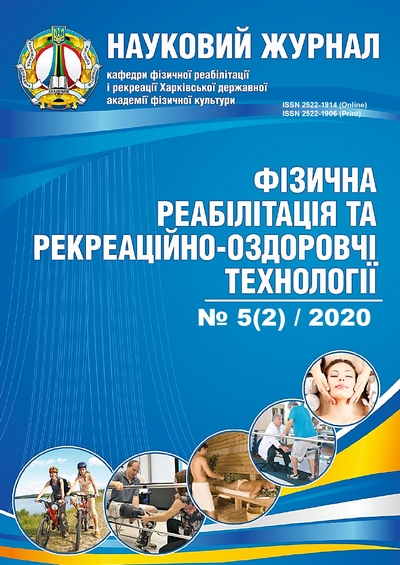Peculiarities of the morpho-functional state of athletes with atypical variants of changes in autonomic heart rate regulation in response to physical exertion
DOI:
https://doi.org/10.15391/prrht.2020-5(2).01Abstract
Purpose: to determine the peculiarities of the morpho-functional parameters of highly qualified athletes, in whom, in response to intense physical activity, atypical variants of changes in the autonomic regulation of the heart rhythm were noted. Material and methods: 202 highly qualified male athletes of various sports took part in the study. In the initial state, routine measurements of body size and body functions were carried out according to standard methods, Kerdo index, Robinson index, Baevsky's adaptation potential, level of physical condition were calculated. The cardiorespiratory system was studied using the spiroarteriocardiorhythmography method before the training load (K1), immediately after it (K2), as well as the next morning after training (K3). Heart rate variability was analyzed according to the method proposed by N.I. Shlyk Athletes with atypical variants of changes in the autonomic regulation of heart rhythm were identified, which indicated the probable development of overfatigue (GS1 – 9 people) and overstrain according to the sympathetic (GS2 – 10 people) and parasympathetic types (GS3 – 9 people). Results: the determined morpho-functional features of athletes allow us to assume that in the development of overfatigue, one of the important indicators is a decrease in the vital index and an increase in Baevsky AP, with a persistent predominance of sympathetic influences, a greater content of fat mass and an increase in diastolic blood pressure against the background of unchanged systolic blood pressure are important blood pressure, with a persistent predominance of parasympathetic influences, low body mass index, chest circumference against the background of increased mobility, as well as significant changes in indices that determine pronounced economization of the cardiovascular system and predict high work capacity are important. Conclusions: In general, the identified features do not provide a clear opportunity to predict the development of atypical changes in the autonomic regulation of the cardiovascular system in response to intense physical exertion, but they can be useful in determining the states of training, overfatigue and overstrain of the athletes' body.
References
Абрамова, Т. Ф., Никитина, Т. М., Кочеткова, Н. И. (2013). Лабильные компоненты массы тела – критерии общей физической подготовленности и контроля текущей и долговременной адаптации к тренировочным нагрузкам. Методические указания. М.: ООО Скайпринт.
Агаджанян, Н. А., Баевский, Р. М., Берсенева, А. П. (2006). Проблемы адаптации и учение о здоровье. М.: РУДН.
Апанасенко, Г. Л., Попова, Л. А., Маглеваный, А. В. (2012). Санология. Основы управления здоровьем. Saarbrukken: Lambert Academic Publishing.
Баевский, Р. М., Берсенева, А. П. (2008). Введение в донозологическую диагностику. М.: Слово.
Дорохов, Р. Н., Губа, В. П. (2002). Спортивная морфология. М.: СпортАкадемПресс.
Дорохов, Р. Н., Чернова, В. Н., Бубненкова, О. М. (2016). Интеграция соматометрических и функциональных показателей детей и подростков. Известия Смоленского государственного университета. 1 (33), 291-297.
Гузій, О. В. (2019). Зміни типів автономної регуляції серцевого ритму за впливу інтенсивних фізичних навантажень. Науковий часопис НПУ імені М.П. Драгоманова, 10(118), 43-49.
Запорожан, В. Н. (ред.). (2014). Факторы и механизмы саногенеза. Одесса: ОНМедУ.
Крыжановский, Г. Н. (ред.). (2002)..Дизрегуляционная патология. М.: Медицина.
Романчук, А. П. (2005). Вегетативная регуляция кардиореспираторной системы в динамике годичного тренировочного цикла. Теория и практика физической культуры, 6, 42-45.
Романчук, А. П. (2003). Концептуальные предпосылки саногенетического мониторинга лиц, занимающихся физической культурой и спортом. Теория и практика физической культуры, 1, 50-53.
Романчук, А. П., Гузий, О. В. (2014). Антропометрические корреляты реакции сердечно-сосудистой системы на стандартную физическую нагрузку спортсменов игровых видов спорта. Journal of Health Sciences, 4(7):037–046.
Романчук, А. П., Овчарек, А. М., Браславский, И. А. (2006). Вегетативное обеспечение кардиореспираторной системы спортсменов различных специализаций. Теория и практика физической культуры, 7, 48-50.
Романчук, О. П. (2010). Лікарсько-педагогічний контроль в оздоровчій фізичній культурі. Одеса: Букаєв В.В.
Сокрут, В. Н., Казаков, В. Н. (ред.). (2011). Медицинская реабилитация в спорте. Донецк: «Каштан».
Шлык, Н. И. (2009). Сердечный ритм и тип регуляции у детей, подростков и спортсменов. Ижевск.
Guziy, O. V., Romanchuk, A. P. (2017). Multifunctional determinants of athletes’ health Journal of Medicine and Health Research. 2(1), 12–21.
Pivovarov, V. V. (2011). Information-measuring system for functional diagnostics of nervous regulation of blood circulation. Part II. The implementation. Automation and remote control. 72(3), P.671–676. doi: 10.1134/S0005117911030192
Романчук О.П., Гузій О.В. (2020). Сучасні підходи до об’єктивізації функціонального стану організму спортсменів при поточних обстеженнях. Фізична реабілітація та рекреаційно-оздоровчі технології. № 5(1). С. 8-18.
Downloads
Published
Issue
Section
License
Copyright (c) 2021 О.В. Гузій, О.П. Романчук, А.В. Магльований

This work is licensed under a Creative Commons Attribution 4.0 International License.

 Dear authors!
Dear authors!